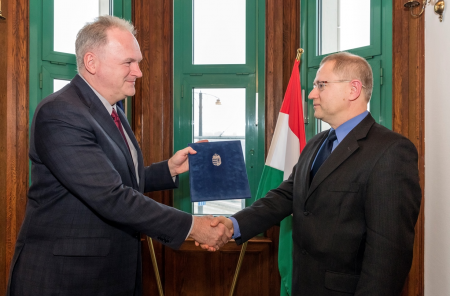The European laser research infrastructure will become complete once the facility in Szeged is put into operation and will be organised into a European Research Infrastructure Consortium (ERIC) together with its Prague and Bucharest counterparts. After the establishment of the ELI-ERIC, consortium members will pay membership fees to cover the operating costs of the equipment. If the consortium is established, the Hungarian central budget is estimated to contribute annually HUF 2.4 billion (nearly EUR 9 million) to the operating costs of the facility.
In order to organise the ELI-ERIC consortium, search for potential consortium members, promote the domestic and international utilisation of ELI research capacities and conduct the related intergovernmental consultations, József Pálinkás, President of the NRDI Office proposed the appointment of Zsolt Fülöp, Doctor of the Hungarian Academy of Sciences (HAS), former Director of the HAS Institute for Nuclear Research, as envoy extraordinary.
The building complex in Szeged, home to the laser research infrastructure, is scheduled to be launched in spring 2017, while the operation is expected to reach its full capacity in 2019, after the assembly and test operation of the equipment. ELI-ERIC will be a service-oriented laser research infrastructure where the researcher community will have access to the latest technologies in laser science. The completed project is expected to stimulate regional investments in the countries hosting the ELI research centres: the Czech Republic, Hungary and Romania.
ELI Attosecond Light Pulse Source (ELI-ALPS)
The Szeged-based institute stands out from the world’s largest facilities producing high intensity laser pulses with the highest number of pulses per one second, which also means the shortest pulse duration. The primary mission of the ELI Attosecond Light Pulse Source (ELI-ALPS) is to apply a broad range of light sources producing ultra-short pulses, including in particular coherent extreme ultraviolet (XUV) and X-ray radiation, and attosecond pulses. Another main element in the facility’s mission is to promote the scientific and technological developments necessary for delivering peak intensity pulses of 200 PW. The ELI-ALPS will primarily provide access to the laser sources and the unique combination of the resulting secondary light and particle impulses for scientific research applications, and the share of use for industrial application will be restricted to only 5%.
On 1 October 2009 in Prague, the ELI Steering Committee decided that the Czech Republic, Hungary and Romania can jointly implement the ELI shared infrastructure. This is the first time that a large shared research infrastructure will be built in new EU Member States. The Szeged-based facility will focus on attosecond pulses, Prague will build the beamline capable of “firing” super-powerful blasts of light ten times a second from secondary sources, and Bucharest will build a photonuclear research centre for the examination of the application of high-output lasers in nuclear physics.







